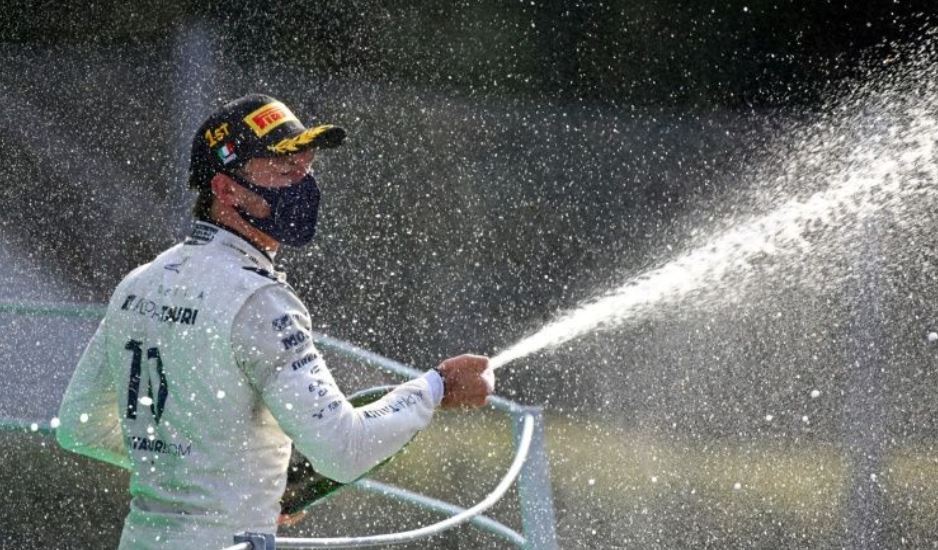

By Nicki Bourlioufas
As Pierre Gasly recently celebrated his F1 victory in Monza – the first Frenchman to do so since 1996 – the Champagne cork was popping hard on the podium. But with which Champagne brand was Gasly celebrating?
It was Moët & Chandon, the king among the LVMH’s vast stable, which dominates global Champagne sales and brand awareness.
Tell us here whether you think men who pop a cork (outside of F1) are ‘real’ men . In some nations like Australia, some men refuse to drink bubbly wine in public.
That may be no surprise, but Moet & Chandon only recently returned to F1 as official Champagne supplier, as the relationship with former official supplier Champagne Carbon has been ‘discontinued,’ according to news reports.
Yet Champagne Carbon still features here as F1’s Champagne partner on the sport’s corporate website. World Wine Watch contacted F1 and Champagne Carbon for a comment but has not received an answer yet.
Champagne Carbon was the official Champagne supplier to Formula 1 since the 2017 F1 season and had signed up until 2021. But that’s recently changed, as we saw Gasly on the podium with Moet & Chandon. As per news reports, Champagne Carbon has apparently discontinued supply due to the COVID-19 pandemic.
So what is Champagne Carbon? The new brand is founded by Alexandre Mea, heir of five winegrower generations to the Devavry Family. The maison has used “high-end technologies and traditional methods Carbon champagnes breaks the rules and disrupt the world of Champagne.”
Each of the Champagne Carbon bottles are coated with the same type of carbon fibre used in the manufacture of the Formula 1 cars. Mea has created a bottle “with a strong identity,” and far away from what the maison calls “the conventions and stereotypes of the [Champagne] region”.
Mea said in 2017 when signing up as F1 official bubbly supplier that the bottle made with carbon well represents “the amazing technology in [F1] sport,” and that Champagne Carbon is “the perfect product for the drivers to celebrate with on a Formula 1 Grand Prix podium.”
But what’s inside?
“An atomic ballet, a body of exceptionally refined bubbles begins its frenetic dance. A persistent, creamy foam welcomes the new arrivals to a fizzing, popping celebration. The pale golden colour announces a transition to a bouquet in a timeless eulogy,” says the company’s website.
“Through the Carbon wrap that covers our bottles, we link and fuse two types of energy: the Carbon on the outside, the carbon dioxide of the Champagne bubbles on the inside.
“In this way we confirm the existence of interactions, with a kind of exchange occurring, and the pure expansion of our wines being nourished by the material adorning our bottles. Continuity between the source and the elements born out of the source, a physical alchemy whereby the effervescence picks up on the DNA and the power line is charged.”
That’s some description. Perhaps some of the finesse is lost in translation from the French to English or the copywriters were a bit too charged up themselves.
But it’s not all hype. Champagne Carbon Brut enjoys a 90/100 Decanter World Wine Award and is blended from 50% Chardonnay, 25% Pinot Noir, 25% Meunier after spending six years on lees. Cellar ageing for a minimum of five years and made with grand crus from some of the most prestigious vineyards in Champagne help create the brand’s prestige.
Champagne Carbon Brut retails in Europe at €220 and Europeans can buy it online here.
But outside of the Continent, you’ll have to rely on those dramatic tasting notes.
As for Gasly, he’ll hopefully get more podiums. One things for sure, whether or not he drinks bubble off the podium, no doubt there isn’t’ a can of RedBull in sight. Congratulations to him!
While it costs, you’re paying for the research and technology behind the brand . Each bottle of Champagne Carbon, available since 2013, comes wrapped in carbon cloth, a process that took Me four years to develop. The process requires a master craftsman a full week for each bottle and 21 highly precise steps to complete.
